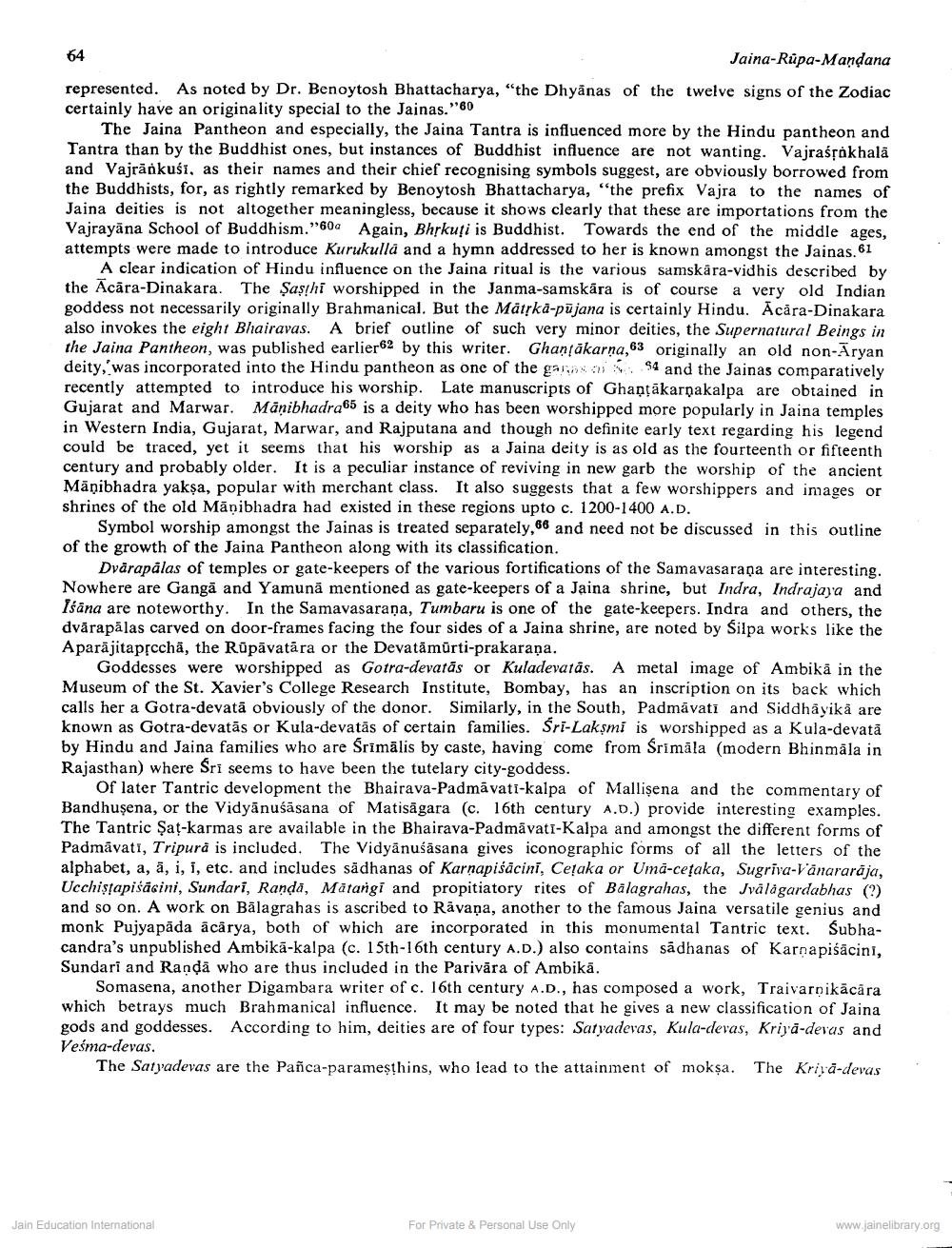________________
Jaina-Rupa-Mandana
represented. As noted by Dr. Benoytosh Bhattacharya, "the Dhyanas of the twelve signs of the Zodiac certainly have an originality special to the Jainas."60
64
The Jaina Pantheon and especially, the Jaina Tantra is influenced more by the Hindu pantheon and Tantra than by the Buddhist ones, but instances of Buddhist influence are not wanting. Vajraśṛakhalā and Vajränkusi, as their names and their chief recognising symbols suggest, are obviously borrowed from the Buddhists, for, as rightly remarked by Benoytosh Bhattacharya, "the prefix Vajra to the names of Jaina deities is not altogether meaningless, because it shows clearly that these are importations from the Vajrayana School of Buddhism."60a Again, Bhrkuți is Buddhist. Towards the end of the middle ages, attempts were made to introduce Kurukulla and a hymn addressed to her is known amongst the Jainas. 61
A clear indication of Hindu influence on the Jaina ritual is the various samskara-vidhis described by the Acara-Dinakara. The Şaşthi worshipped in the Janma-samskära is of course a very old Indian goddess not necessarily originally Brahmanical. But the Matṛka-pujana is certainly Hindu. Acara-Dinakara also invokes the eight Bhairavas. A brief outline of such very minor deities, the Supernatural Beings in the Jaina Pantheon, was published earlier62 by this writer. Ghantäkarna,63 originally an old non-Aryan deity, was incorporated into the Hindu pantheon as one of the gas 54 and the Jainas comparatively recently attempted to introduce his worship. Late manuscripts of Ghaṇṭākarpakalpa are obtained in Gujarat and Marwar. Manibhadra65 is a deity who has been worshipped more popularly in Jaina temples in Western India, Gujarat, Marwar, and Rajputana and though no definite early text regarding his legend could be traced, yet it seems that his worship as a Jaina deity is as old as the fourteenth or fifteenth century and probably older. It is a peculiar instance of reviving in new garb the worship of the ancient Manibhadra yakṣa, popular with merchant class. It also suggests that a few worshippers and images or shrines of the old Māṇibhadra had existed in these regions upto c. 1200-1400 A.D.
Symbol worship amongst the Jainas is treated separately, 66 and need not be discussed in this outline of the growth of the Jaina Pantheon along with its classification.
Dvarapalas of temples or gate-keepers of the various fortifications of the Samavasarana are interesting. Nowhere are Ganga and Yamuna mentioned as gate-keepers of a Jaina shrine, but Indra, Indrajaya and Iśāna are noteworthy. In the Samavasaraṇa, Tumbaru is one of the gate-keepers. Indra and others, the dvārapālas carved on door-frames facing the four sides of a Jaina shrine, are noted by Silpa works like the Aparajitaprecha, the Rūpāvatira or the Devatamurti-prakarapa.
Goddesses were worshipped as Gotra-devatās or Kuladevatās. A metal image of Ambika in the Museum of the St. Xavier's College Research Institute, Bombay, has an inscription on its back which calls her a Gotra-devata obviously of the donor. Similarly, in the South, Padmavati and Siddhayika are known as Gotra-devatās or Kula-devatās of certain families. Śri-Lakṣmi is worshipped as a Kula-devatā by Hindu and Jaina families who are Śrīmālis by caste, having come from Śrīmāla (modern Bhinmala in Rajasthan) where Śri seems to have been the tutelary city-goddess.
Of later Tantric development the Bhairava-Padmavati-kalpa of Mallişena and the commentary of Bandhusena, or the Vidyānuśāsana of Matisagara (c. 16th century A.D.) provide interesting examples. The Tantric Şat-karmas are available in the Bhairava-Padmavati-Kalpa and amongst the different forms of Padmavati, Tripura is included. The Vidyanuśāsana gives iconographic forms of all the letters of the alphabet, a, a, i, i, etc. and includes sädhanas of Karnapisacini, Cetaka or Uma-ceṭaka, Sugrīva-Vānararāja, Ucchiṣṭapisäsini, Sundari, Randa, Matangi and propitiatory rites of Balagrahas, the Jvälägardabhas (?) and so on. A work on Balagrahas is ascribed to Rävaṇa, another to the famous Jaina versatile genius and monk Pujyapāda ācārya, both of which are incorporated in this monumental Tantric text. Subhacandra's unpublished Ambika-kalpa (c. 15th-16th century A.D.) also contains sadhanas of Karṇapiśācini, Sundari and Randa who are thus included in the Parivara of Ambikā.
Somasena, another Digambara writer of c. 16th century A.D., has composed a work, Traivarṇikācāra which betrays much Brahmanical influence. It may be noted that he gives a new classification of Jaina gods and goddesses. According to him, deities are of four types: Satyadevas, Kula-devas, Kriya-devas and Veśma-devas.
The Satyadevas are the Pañca-parameșthins, who lead to the attainment of mokṣa. The Kriya-devas
Jain Education International
For Private & Personal Use Only
www.jainelibrary.org




